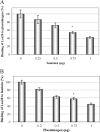The novel leptospiral surface adhesin Lsa20 binds laminin and human plasminogen and is probably expressed during infection
- PMID: 21844229
- PMCID: PMC3257903
- DOI: 10.1128/IAI.05583-11
The novel leptospiral surface adhesin Lsa20 binds laminin and human plasminogen and is probably expressed during infection
Abstract
Leptospirosis is an emerging infectious disease caused by pathogenic species of Leptospira. In this work, we report the cloning, expression, purification, and characterization of two predicted leptospiral outer membrane proteins, LIC11469 and LIC11030. The LIC11469 protein is well conserved among leptospiral strains, while LIC11030 was identified only in Leptospira interrogans. We confirmed by surface proteolysis of intact leptospires with proteinase K that these proteins are most likely new surface leptospiral proteins. The recombinant proteins were evaluated for their capacity to attach to extracellular matrix (ECM) components and to plasminogen. The leptospiral protein encoded by LIC11469, named Lsa20 (leptospiral surface adhesin of 20 kDa), binds to laminin and to plasminogen. The binding with both components was not detected when Lsa20 was previously denatured or blocked with anti-Lsa20 antibodies. Moreover, Lsa20 binding to laminin was also confirmed by surface plasmon resonance (SPR). Laminin competes with plasminogen for binding to Lsa20, suggesting the same ligand-binding site. Lsa20-bound plasminogen could be converted to enzymatically active plasmin, capable of cleaving plasmin substrate d-valyl-leucyl-lysine-p-nitroanilide dihydrochloride. Lsa20 was recognized by antibodies in confirmed-leptospirosis serum samples, suggesting that this protein is expressed during infection. Taken together, our results indicate that Lsa20 is a novel leptospiral adhesin that in concert with the host-derived plasmin may help the bacteria to adhere and to spread through the hosts.
Figures








Similar articles
-
Characterization of novel OmpA-like protein of Leptospira interrogans that binds extracellular matrix molecules and plasminogen.PLoS One. 2011;6(7):e21962. doi: 10.1371/journal.pone.0021962. Epub 2011 Jul 6. PLoS One. 2011. PMID: 21755014 Free PMC article.
-
Lsa30, a novel adhesin of Leptospira interrogans binds human plasminogen and the complement regulator C4bp.Microb Pathog. 2012 Sep;53(3-4):125-34. doi: 10.1016/j.micpath.2012.06.001. Epub 2012 Jun 23. Microb Pathog. 2012. PMID: 22732096
-
Novel Leptospira interrogans protein Lsa32 is expressed during infection and binds laminin and plasminogen.Microbiology (Reading). 2015 Apr;161(Pt 4):851-64. doi: 10.1099/mic.0.000041. Epub 2015 Jan 27. Microbiology (Reading). 2015. PMID: 25627443
-
Leptospiral extracellular matrix adhesins as mediators of pathogen-host interactions.FEMS Microbiol Lett. 2014 Mar;352(2):129-39. doi: 10.1111/1574-6968.12349. Epub 2013 Dec 11. FEMS Microbiol Lett. 2014. PMID: 24289724 Review.
-
A Review on Host-Leptospira Interactions: What We Know and Future Expectations.Front Cell Infect Microbiol. 2021 Nov 25;11:777709. doi: 10.3389/fcimb.2021.777709. eCollection 2021. Front Cell Infect Microbiol. 2021. PMID: 34900757 Free PMC article. Review.
Cited by
-
Evaluation of immunoprotective activity of six leptospiral proteins in the hamster model of leptospirosis.Open Microbiol J. 2012;6:79-87. doi: 10.2174/1874285801206010079. Epub 2012 Oct 19. Open Microbiol J. 2012. PMID: 23173023 Free PMC article.
-
The interaction of two novel putative proteins of Leptospira interrogans with E-cadherin, plasminogen and complement components with potential role in bacterial infection.Virulence. 2019 Dec;10(1):734-753. doi: 10.1080/21505594.2019.1650613. Virulence. 2019. PMID: 31422744 Free PMC article.
-
Plasminogen binding proteins and plasmin generation on the surface of Leptospira spp.: the contribution to the bacteria-host interactions.J Biomed Biotechnol. 2012;2012:758513. doi: 10.1155/2012/758513. Epub 2012 Oct 15. J Biomed Biotechnol. 2012. PMID: 23118516 Free PMC article.
-
Features of two proteins of Leptospira interrogans with potential role in host-pathogen interactions.BMC Microbiol. 2012 Mar 30;12:50. doi: 10.1186/1471-2180-12-50. BMC Microbiol. 2012. PMID: 22463075 Free PMC article.
-
Multiple activities of LigB potentiate virulence of Leptospira interrogans: inhibition of alternative and classical pathways of complement.PLoS One. 2012;7(7):e41566. doi: 10.1371/journal.pone.0041566. Epub 2012 Jul 23. PLoS One. 2012. PMID: 22911815 Free PMC article.
References
-
- Adu-Bobie J., Capecchi B., Serruto D., Rappuoli R., Pizza M. 2003. Two years into reverse vaccinology. Vaccine 21:605–610 - PubMed
-
- Altschul S. F., Gish W., Miller W., Myers E. W., Lipman D. J. 1990. Basic local alignment search tool. J. Mol. Biol. 215:403–410 - PubMed
-
- Angles-Cano E. 1994. Overview on fibrinolysis: plasminogen activation pathways on fibrin and cell surfaces. Chem. Phys. Lipids 67-68:353–362 - PubMed
-
- Angles-Cano E., de la Pena Diaz A., Loyau S. 2001. Inhibition of fibrinolysis by lipoprotein(a). Ann. N. Y. Acad. Sci. 936:261–275 - PubMed
Publication types
MeSH terms
Substances
Associated data
- Actions
- Actions
LinkOut - more resources
Full Text Sources
Other Literature Sources

